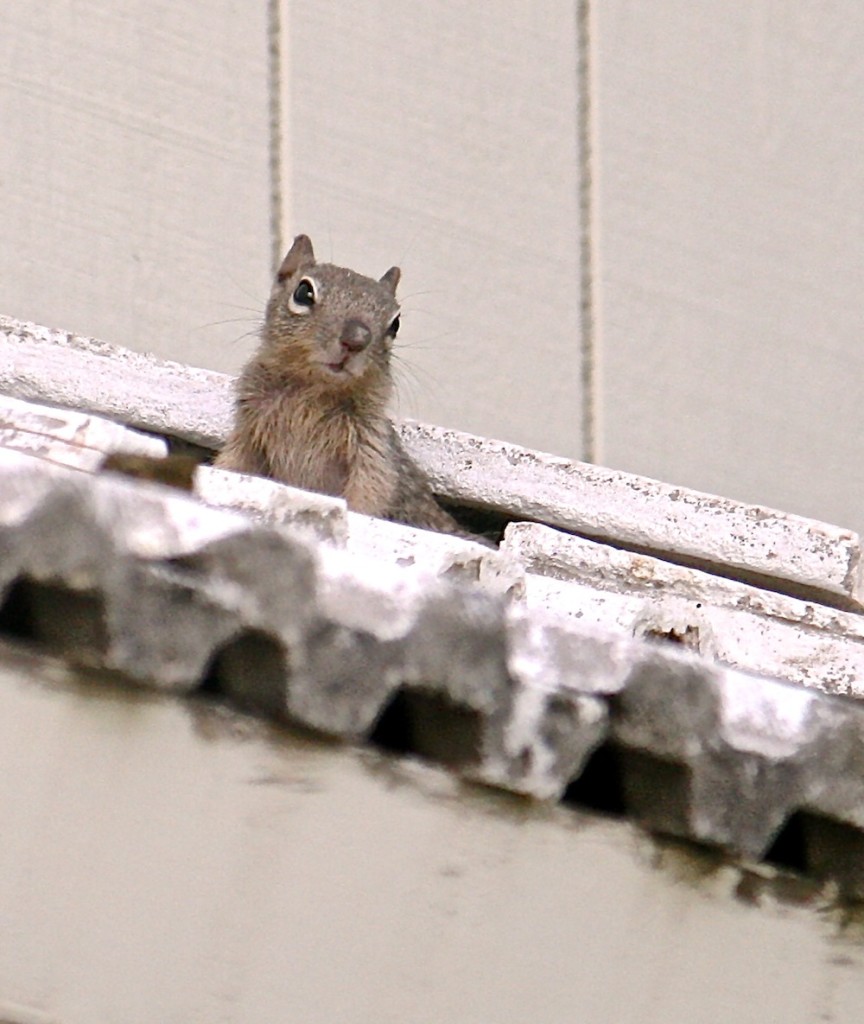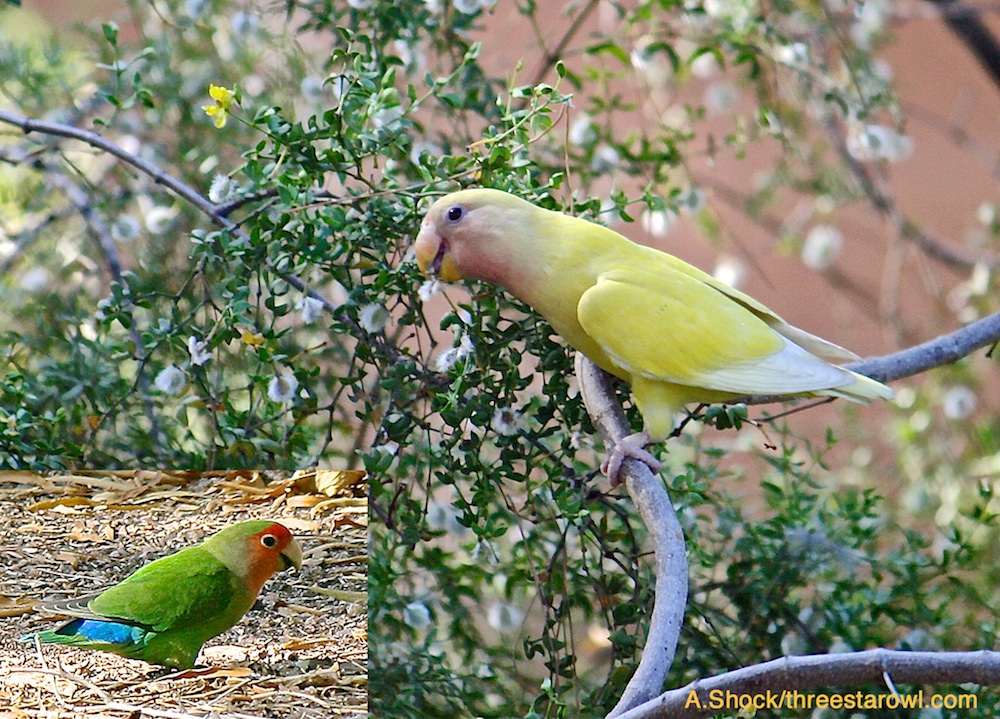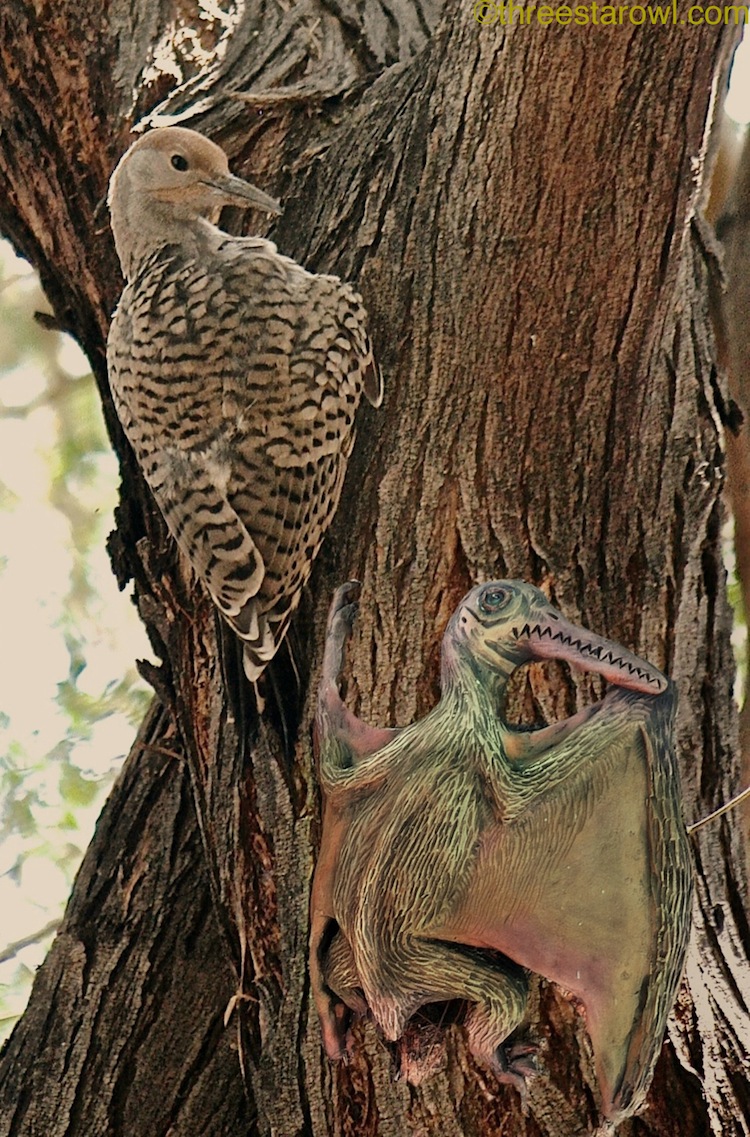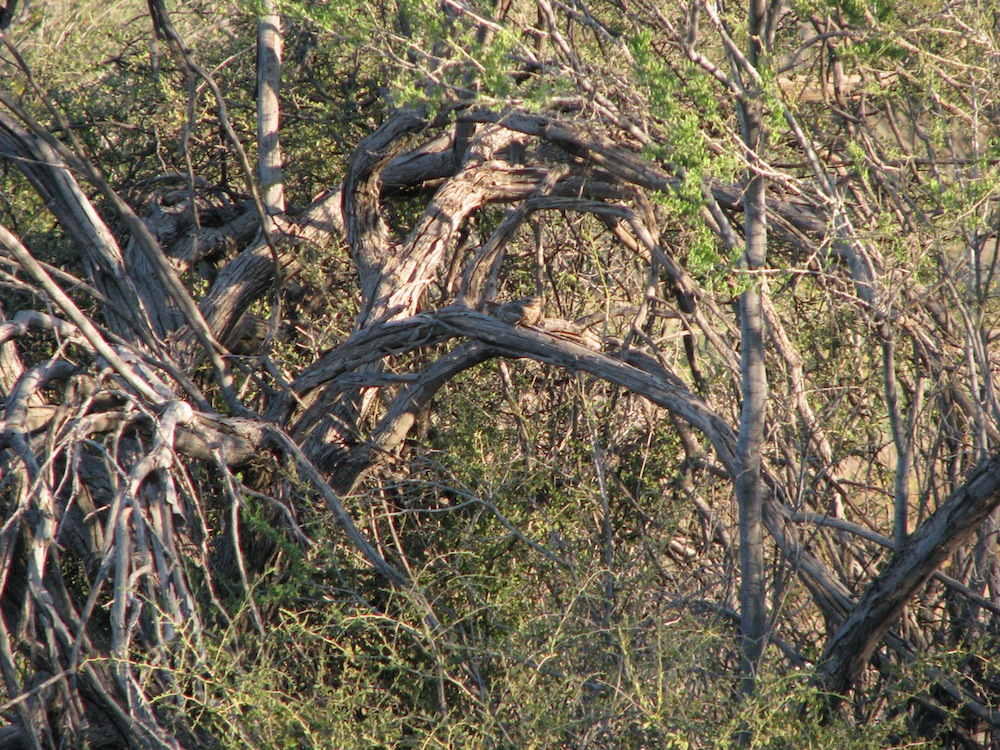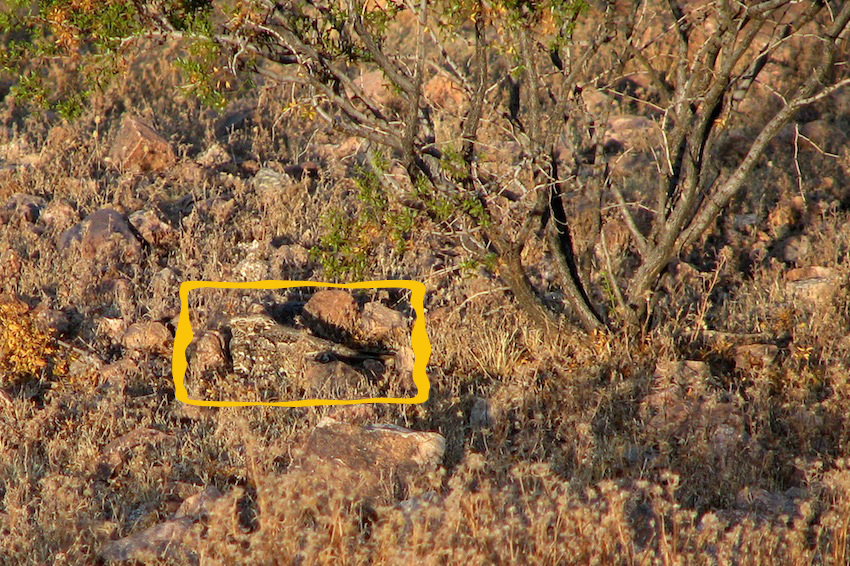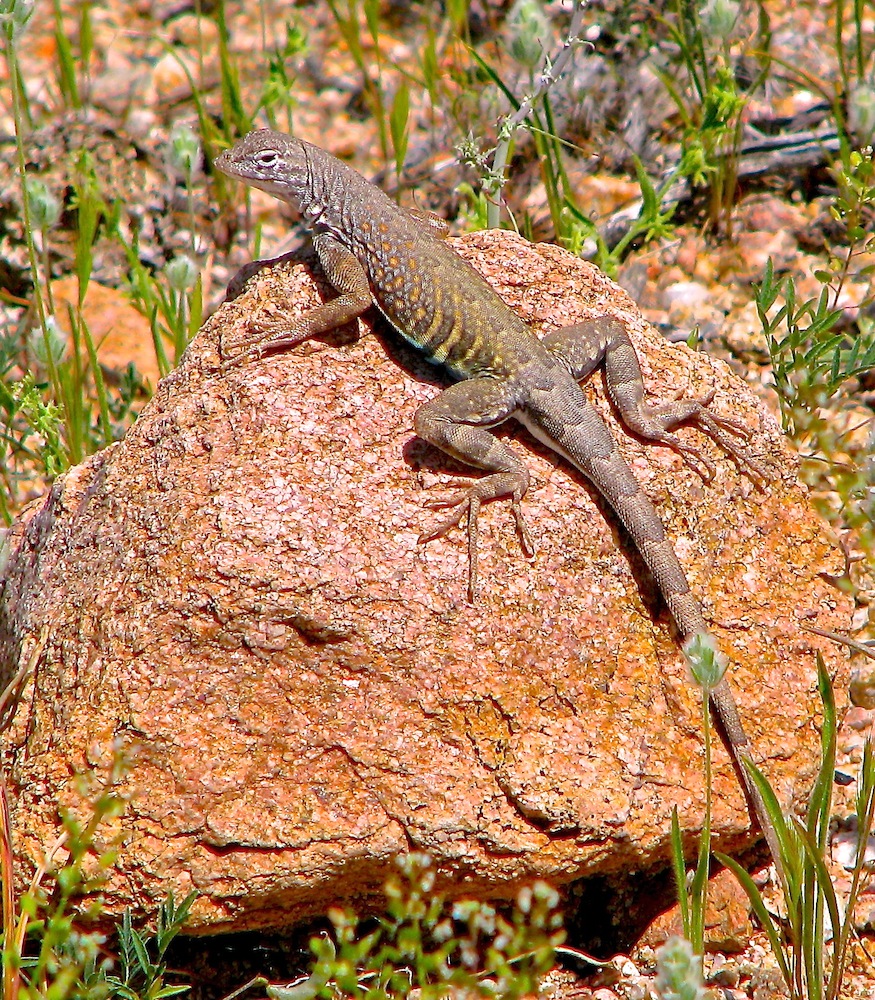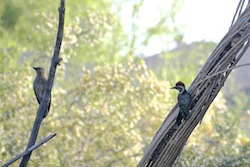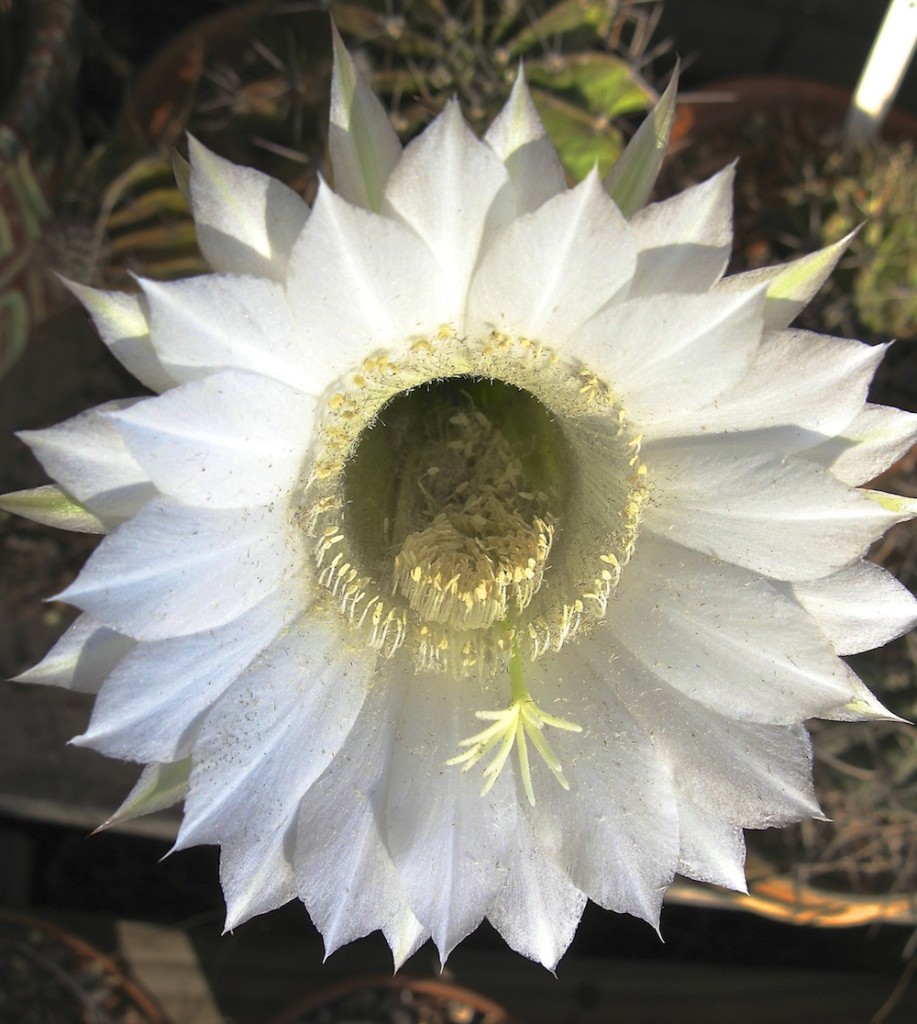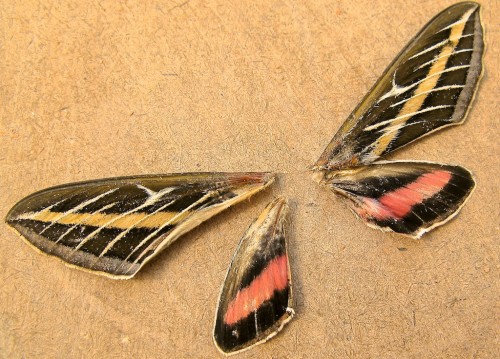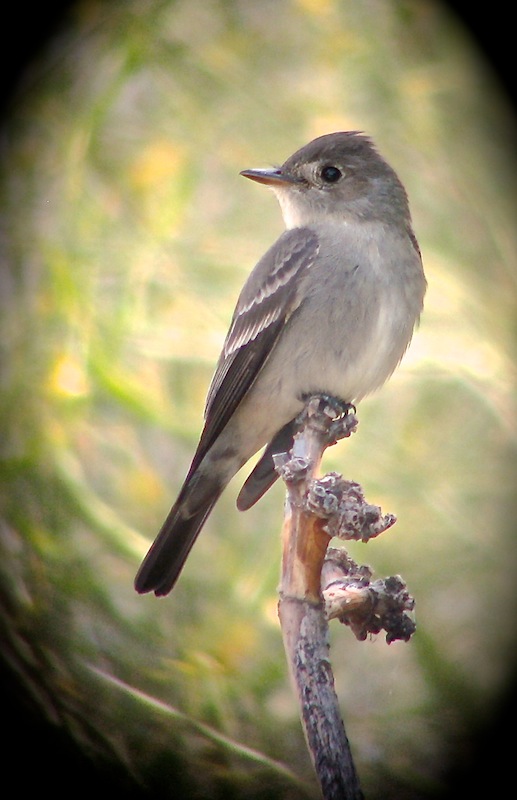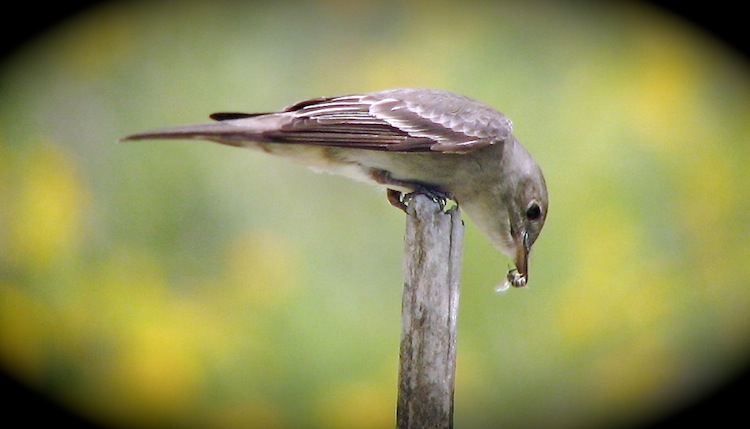Peaches and cream
The young peachy person shown below has been hanging out in our Old Scottsdale yard, eating seed-fluffs off of Creosote bushes. It’s a Rosy-faced Lovebird (Agapornis roseicollis, formerly known as the Peach-faced lovebird) with naturally-occurring variant plumage called “Lutino”. The image inset bottom left shows a bird with the standard “wild” coloration, also photo’d in our yard.
Rosy-faced Lovebirds have been naturalizing themselves in the greater Phoenix area since the mid-1980s, and are probably the descendants of escaped pets. For the full story, read Kurt Radamaker and Troy Corman’s excellent account on the Arizona Field Ornithologists website.
This lemony youngster flies with two “normal”-plumaged individuals, presumably its parents. Although it doesn’t show in this photo, the bird has a few reddish feathers coming in above its beak, the first indication that it will soon sport a coral forehead. Breeders offer this azureless color variant under the name “Lutino”, but the fact that this bird is a youngster suggests that it hatched ferally, and is not an escaped pet.
Update: with a bit of further research, I turned up some info on Lovebird genetics. The Lutino plumage is a sex-linked recessive gene, which means that with two visually “wild”-plumaged parents, a visibly Lutino offspring is always female — our little Lutino is a Lutina.
Variations on a lovebird theme (photos A.Shock)
Spot the Bird: Horizontal Napping Bark
Some birds really do not want to be seen, like certain mothy-plumaged nocturnals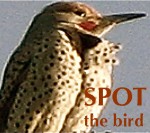 . With their barred and mottled markings, owls and nightjars can blend in day or night with any old thing: bark, stump, or rock. Owls are inclined to hide by perching upright against a trunk — Vertical Napping Bark — while nightjars (nighthawks, whip-poor-wills, and their relatives) often lie flush along a branch — Horizontal Napping Bark.
. With their barred and mottled markings, owls and nightjars can blend in day or night with any old thing: bark, stump, or rock. Owls are inclined to hide by perching upright against a trunk — Vertical Napping Bark — while nightjars (nighthawks, whip-poor-wills, and their relatives) often lie flush along a branch — Horizontal Napping Bark.
Below is some prime Horizontal Napping Bark for you, a Lesser Nighthawk E and I flushed off a desert trail early one morning while hiking. As we approached unknowing, it flew a scant dozen meters away and settled motionless in the middle of a mesquite tangle. We’d seen it land, otherwise we’d never have known it was there. Go ahead, Spot the Bird! Click on the image to enlarge it — it’s still hard to spot.
Lesser Nighthawks (Chordeiles acutipennis) are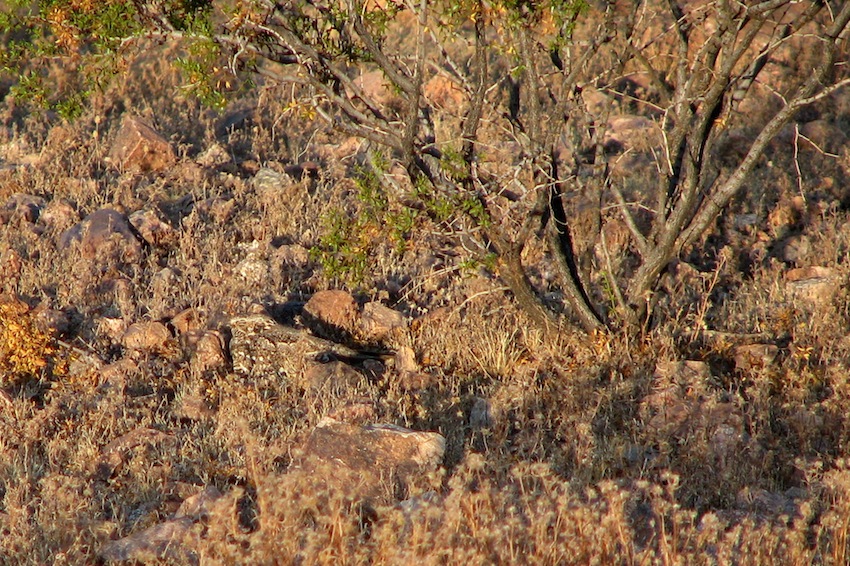 so confident in their camo that they nest out in the open, on rocky desert ground. Here’s one >> trusting to her mottliness to keep from being discovered incubating two eggs in Papago Park. Nesting sites must be chosen carefully to minimize the risk of being accidentally stepped on. Like other camo-reliant ground-nesters such as Killdeer, a Lesser Nighthawk mama will sit tight until the last minute of interloper’s approach (“crouch concealment”), than launch into a wing-fluttering display (“distress simulation”) to distract and draw away the looming threat. If distraction isn’t possible, they will become threatening, by puffing up and gaping their large pink mouths while hissing like a snake.
so confident in their camo that they nest out in the open, on rocky desert ground. Here’s one >> trusting to her mottliness to keep from being discovered incubating two eggs in Papago Park. Nesting sites must be chosen carefully to minimize the risk of being accidentally stepped on. Like other camo-reliant ground-nesters such as Killdeer, a Lesser Nighthawk mama will sit tight until the last minute of interloper’s approach (“crouch concealment”), than launch into a wing-fluttering display (“distress simulation”) to distract and draw away the looming threat. If distraction isn’t possible, they will become threatening, by puffing up and gaping their large pink mouths while hissing like a snake.
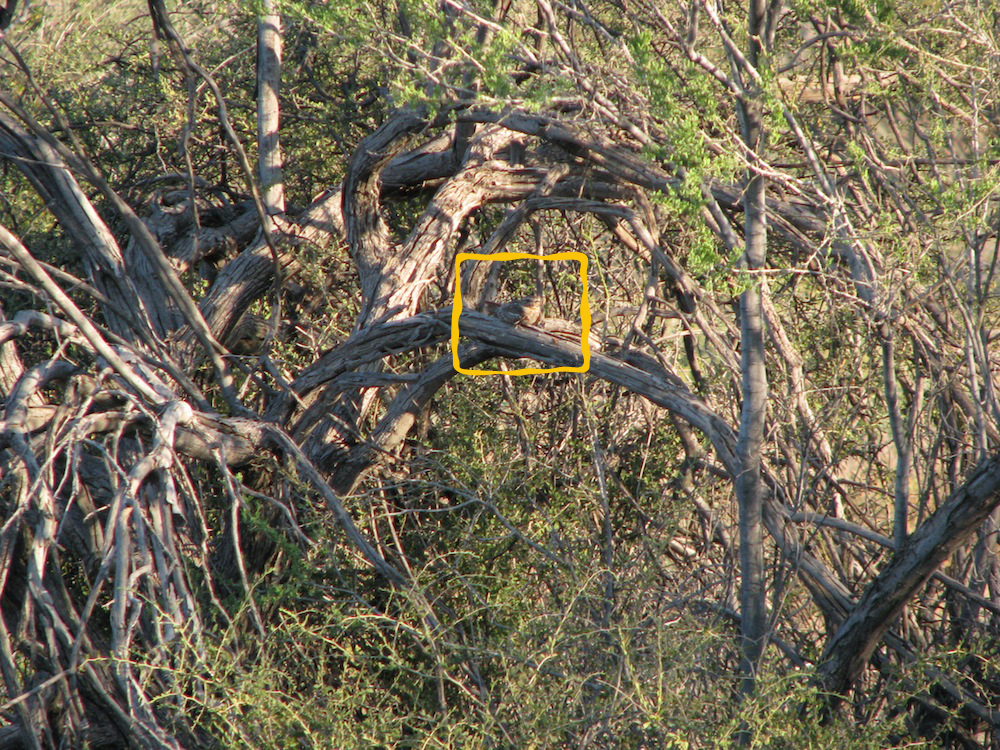 If you need a bit of help finding the Horizontal Napping Bark/Kipping Cobble in the photos, here are the keys, with the birds inside the wavery yellow boxes.
If you need a bit of help finding the Horizontal Napping Bark/Kipping Cobble in the photos, here are the keys, with the birds inside the wavery yellow boxes.
They’re both large files, so click to enlarge (both photos A.Shock).
And, watch your step!
Orton’s ladderback — remedial photoshop strikes again
I heard a sharp “pik” in the backyard this morning, so I grabbed the long lens and went out to look for the male Black-headed Grosbeak I’d heard and briefly glimpsed at dawn from the comfort of bed (birdwatching from bed is one of the things I love about the big sliding door in our bedroom — I should keep a bed-list: Harris’s hawk, Cooper’s hawk, three species of hummers, two owls heard, Gray fox, raccoons, etc, etc. Really, it’d be a pretty good list for mattress-based observation). Unfortunately, later in the day, no Grosbeak could be found.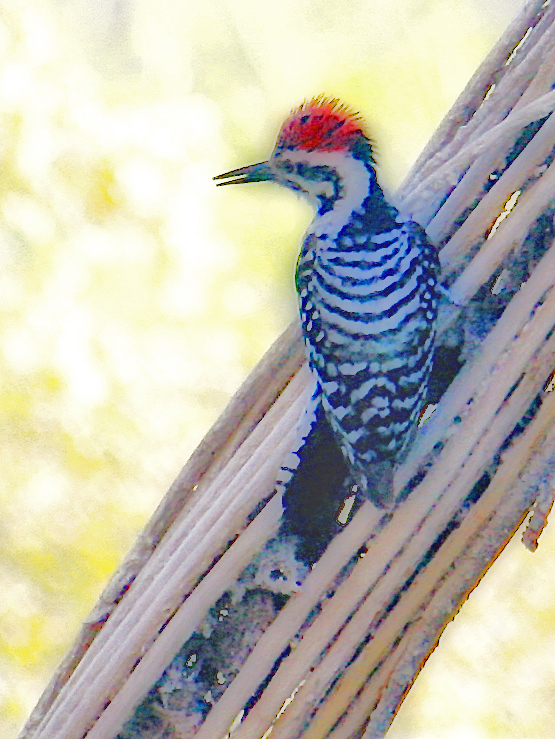
Instead, the generator of the “pik” call was a male Ladder-backed Woodpecker (Picoides scalaris) being shown the door by a Gila Woodpecker. Because the squabble was moving swiftly west across the yard, I managed only two or three shots and none of them were great.
The subject birds were in the shade with a brightly lit background, and because of the action, low light, and distance nothing was terribly sharp. But the Ladderback had perched fetchingly on a saguaro skeleton, and I decided to try to salvage the shot.
The result is above, a manipulated photo-based digital image, “overedited” for sure but pleasing nevertheless, with a painterly quality that captures the gist of the little woodpecker and his eponymous barred back. Not to mention his hilarious spiky red chapeau!
Below is the undistinguished original image for comparison, with the Gila Woodpecker off to the left:
The process was hit or miss, and I don’t recall each step. But I started by cropping the shot heavily, then I ran it through a few filters (including the canned Orton filter effect) and stopped tweaking when I liked the look.
(Photos A.Shock)
Dragon-wing rug
If you had a dragon-wing rug — I do mean a rug made out of dragon wings — and it was terribly old and worn but still in use in the family home, and it lay on the floor of a room at the back with a couple of big armchairs to fold up in and lots of dark wooden bookshelves and not many windows, the rug would probably have fringy bits along the edges, and worn patches where you could see leathery underlayments where the scaly feathers attached, and it might still glitter a little with rainbow membranes. In fact it might look a lot like this:
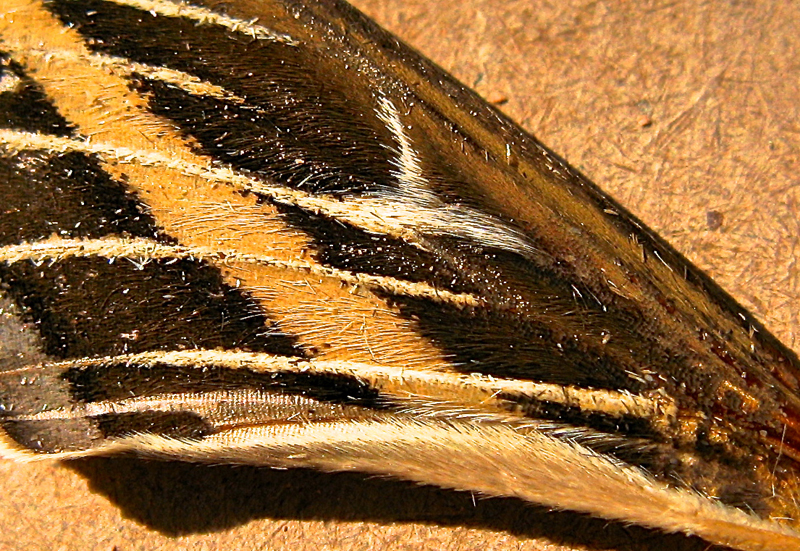
White-lined sphinx moth wing detail
This isn’t a dragon wing, it’s the wing of a sphinx (a mystical and legendary creature in itself) but in this case the moth version. All four of the moth’s wings were discarded by an ærial predator over our yard last night, and all four wings fluttered to the 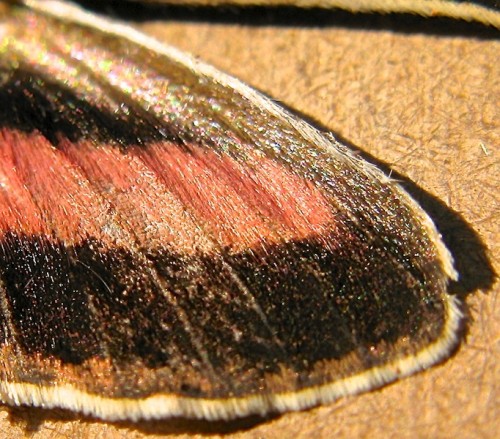 ground and settled within feet of each other. An owl, or a bat, or a nighthawk had shucked it, perhaps — the body would have made a fat protein-rich mouthful but the wings are dry and awkward to swallow, so the predator neatly clipped them and let them fall.
ground and settled within feet of each other. An owl, or a bat, or a nighthawk had shucked it, perhaps — the body would have made a fat protein-rich mouthful but the wings are dry and awkward to swallow, so the predator neatly clipped them and let them fall.
Given this scenario of on-the-wing food prep, the question remains — if you had a dragon-wing rug — what sort of hunter could do that to a dragon?
(All photos A.Shock, click to enlarge!)
Old bird, new spelling
Apparently, it’s spelled Wood-Pewee. And, no, it’s not that the American Ornithological* Union has changed its mind (although that’s been known to happen) — it’s that after decades of birding, I just learned how to spell “Pewee”. All this time I thought it was “Peewee”.
That’s a good thing about birding: refresh, reset, renew.
Even if it’s only orthographic renewal.
>> right, Migrating Western Wood-Pewee (Contopus sordidulus). Below: same bird with a bee for lunch. (Photos A.Shock, digiscoped with a 65mm Zeiss spotting scope and my ancient Canon G7 point-and-shoot)
And speaking of needing refreshment, this little guy (or gal) has come from his winter home in Ecuador (or elsewhere in northern or western South America) to rest in our yard for a day, and to tank up on flying insect fuel. He’s on his way to his woodland breeding grounds north and uphill from here, and he could be almost there if he’s headed to Arizona’s Mogollon Rim. Or he could still have a long way to go, if his destination is inland Alaska. I asked him where he was going, but he was too polite to answer with a beakful of bugs.
All the way from South America! I think we can spare him a bee or two.
*Oh, and by the way, it’s “American Ornithologists‘ Union”, not “Ornithological“. Apparently, spelling pewee isn’t the only new thing I learned today.

